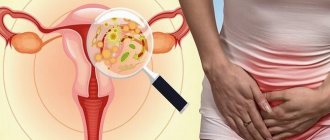Benefits of suppositories
In gynecological practice, vaginal suppositories inserted into the vagina are often used. The use of suppositories is sometimes compared to injections, since the active substance of the drug exerts its effect quite quickly, being absorbed through the walls of the vagina into the bloodstream.
The vaginal mucosa has a large number of blood vessels, which facilitates the rapid entry of the medicinal substance from the suppository into the bloodstream. This will take no more than 20 minutes. The active substance moves through the bloodstream and enters the site of inflammation, where it fights pathogenic microflora. Suppositories quickly help eliminate symptoms of gynecological diseases such as itching, swelling, burning, pain, and discomfort.
Their main advantages are:
- low percentage of side effects;
- fast absorption;
- local effect on the site of inflammation;
- quick results;
- the medicine enters directly into the bloodstream, bypassing the gastrointestinal tract, there is no need to decide how to restore the intestinal microflora.
A distinctive feature of gynecological antibacterial suppositories is that the effect is only on the pelvic organs, practically does not affect the liver, kidneys, and gastrointestinal tract (a small part of the drug gets there). Therefore, after taking antibiotics in this form, you do not need to take drugs with bifidobacteria and lactobacilli.
Signs of thrush
The clinical picture of thrush resembles a sexually transmitted disease, but in reality it is not one, although the pathogen can in some cases be sexually transmitted.
The name of this disease speaks for itself. With candidiasis, a woman experiences the appearance of cheesy white or yellowish vaginal discharge, which smells unpleasant, reminiscent of sour fermented milk product. In this case, patients may experience itching and burning in the genital area. Urination is accompanied by burning pain, and sexual intercourse and bathing cause severe discomfort. The disease is more common in women, but it is also possible in men and is accompanied by the same symptoms.
How does candidiasis manifest?
Clinical symptoms of thrush in women:
- itching and burning of the genitals;
- copious white discharge in the form of curdled cottage cheese with a sour odor;
- painful sexual intercourse;
- difficulty urinating;
- redness and swelling of the mucous membranes of the external genitalia.
Without timely treatment, thrush becomes chronic and is characterized by periodic relapses. It can provoke the development of inflammation of the uterus, appendages, candidiasis of the rectum and other organs of the pelvic area.
How severe thrush appears after antibiotics depends on the duration of therapy, dosage of tablets, general condition of the body and nutrition.
Why does the composition of microflora change?
- acute and chronic systemic infections;
- decreased immunity due to diseases of the blood and hematopoietic organs;
- treatment with certain drugs (antibiotics, cytostatics, hormonal agents);
- in case of violation of intimate hygiene rules;
- after douching;
- when using aggressive detergents;
- with irregular replacement of pads and tampons;
- after a change in climatic conditions;
- after shocks and stress;
- against the background of exhaustion of the body (malnutrition, vitamin deficiency);
- with frequent changes of sexual partners;
- after contact with the mucous membrane of STI pathogens;
- in case of dietary violations, switch to simple carbohydrates.
A woman’s task is to promptly notice adverse changes and reverse them. Otherwise, her reproductive health will be at risk.
The most effective vaginal suppositories
Antibacterial suppositories for gynecological purposes are of a wide spectrum of action, which are universal and can destroy several types of pathogenic microorganisms at once, and of a narrow focus, which can get rid of a specific type of bacteria. Therefore, before use, you must carefully study the instructions for the drug and be sure to consult your doctor. Then the treatment will be effective.
Terzhinan. These suppositories cope with many pathogenic microorganisms. They effectively fight viruses, staphylococci, mycobacteria, and E. coli. With the help of Terzhinan suppositories, thrush, infectious lesions of the vagina, and bacterial vaginismus are treated. Terzhinan is also used before carrying out diagnostic and surgical measures to examine the uterus.
Terzhinan contains neomycin, nystatin, prednisolone, ternidazole, sodium metasulfobenzoate, which have a powerful antihistamine, anti-inflammatory, and anti-exudative effect.
Suppositories are moistened with water before use and inserted deeply into the vagina at night. During treatment, you need to use sanitary pads, as discharge after antibiotics is bright yellow, because Terzhinan is excreted along with vaginal secretions.
Suporon. Rectal-vaginal suppositories. They have an antiseptic, anti-inflammatory, analgesic effect. Copes perfectly with endometritis, erosion, colpitis.
Betadine. Has an antiseptic and disinfectant effect. The composition contains iodine, which penetrates shallowly into tissues, destroying pathogens, fungi, and viruses.
Suppositories with Diclofenac. With the help of diclofenac suppositories, polycystic disease, inflammation of the ovaries, cysts, and genital infections are treated. As a preventative measure, suppositories are used after gynecological operations, after abortions and miscarriages.
Pimafucin. Used to treat sulvovaginitis caused by colonies of Candida fungi. The active ingredient of the drug is natamycin, an antibiotic of the macrolide group.
Meratin combi. Used for fungal vaginosis, trichomonas vaginitis. Candles can be used for at least 10 days, including even the days of menstruation.
Longidaza. This is a modern pharmacological drug that can effectively take part in eliminating inflammatory processes in the pelvic organs. Perfectly relieves swelling and has a restorative effect on the affected epithelium.
Livarol. One of the best suppositories that effectively fights candidiasis. It has an inhibitory effect on colonies of Candida fungi.
Methyluracil. These vaginal suppositories containing antibiotics are very popular among the female population. They quickly relieve inflammatory processes in the female genitourinary and excretory systems, stimulate epithelial healing, restoring cellular structure, and help improve metabolism. The suppositories begin to act almost instantly, quickly absorbing into the vaginal mucosa.
Indomethacin. The product is available in tablet form. Eliminates heat, fever, inflammation, provides excellent pain relief. Indomethacin suppositories are prescribed for inflammation of the appendages, fibroids, cysts, and menstrual irregularities. One suppository may contain 50 and 100 mg of active substance.
Mikozhinax. The drug contains powerful components. Nystatin, which destroys fungi, Dexamethasone, which has an anti-inflammatory effect, Metronidazole, which kills bacteria, and chloramphenicol, which fights infections.
Acylact. These antibiotic suppositories are made from several types of lactic acid bacteria. The drug has antimicrobial properties, quickly eliminates inflammation, and is harmful to dangerous bacteria. The main useful feature of Acylact is that it is a suppository for restoring microflora in women. The drug is universal; it is used in the treatment of a large number of diseases of the urogenital canal.
Candles with ichthyol. The drug relieves inflammation, pain symptoms, and helps accelerate the healing of mucosal lesions.
Hexicon. A popular drug that helps treat inflammation caused by pathogenic bacteria or infection. The drug is based on chlorhexidine digluconate, an antiseptic substance. Hexicon acts only in areas affected by mycobacteria or foreign microorganisms and does not disturb the microflora of the mucous membrane.
Polygynax. These are antifungal suppositories that contain neomycin and polymyxin B. Suppositories destroy pathogenic microorganisms and fungal infections.
Polygynax kills corynebacteria, Klebsiella, fungi, Protea, Haemophilus influenzae, and staphylococci.
It is used for the treatment of cervicovaginitis, vaginitis, vulvovaginitis, as well as before diagnosing diseases of the uterus, before childbirth, before surgery.
For inflammatory processes in the female reproductive and excretory systems, rectal suppositories are also used. In the rectum, the medicine immediately penetrates into the blood and the therapeutic effect is achieved quickly. Rectal suppositories used in gynecology are Ortofen, Hexicon, Anuzol. These suppositories relieve inflammation, inhibit the activity of pathogenic microorganisms, and reduce temperature.
Prevention
It has always been known that the best medicine is prevention. This is a very important point that allows you to prevent the development of the disease even after taking antibiotics. If you follow simple rules in a timely manner, you can avoid the development of symptoms of thrush after taking antibiotic drugs. To do this, carry out the following procedures:
- Initially, you need to pay special attention to self-care. This item includes taking a shower every evening and morning if necessary. It is important to change pads more often during menstrual periods, as well as change your underwear daily.
- Eat properly. To do this, you need to study the features of the diet, which will strengthen the immune system and improve well-being.
- During sexual activity, use condoms, which help prevent many different sexually transmitted diseases. This point is especially relevant if sexual adventures occur with different partners.
- Treatment of gynecological ailments that can occur at any age.
- To avoid the development of disease complications, it is necessary to visit the gynecological office as often as possible (once every 3–6 months).
- Give up bad habits: smoking, alcohol addiction and drug use.
Therefore, the conclusion can be drawn as follows: the health of each person does not depend on the attending physician, but on proper care of oneself and one’s health.
Sources:
https://molochnicainfo.ru/profilaktika/molochnicy-pri-prieme-antibiotikov/ https://www.medware.ru/gynecology/lechenie-molochnitsy-posle-priema-antibiotikov.html https://netgribkam.ru/molochnica /molochnitsa-posle-priema-antibiotikov.html
Restoration of vaginal microflora using folk and classical means
Changes in the quantitative and qualitative composition of microorganisms populating the vagina are a consequence of infectious and inflammatory diseases. To exclude them in the future, the vaginal microflora is restored. Let's consider the algorithm of the therapeutic process and its features.
There are many factors contributing to the development of this situation. In order to accurately determine what exactly caused the cause in this case, the following is prescribed:
- collection of smears;
- blood test for hormones;
- examination in a gynecological chair;
- anamnesis collection.
Among the main reasons for the development of the disorder:
- hypothermia, which provokes a decrease in local immunity;
- disruption of the functioning of the hormonal system - cycle failure (lengthening or shortening of menstruation, volume of discharge), pregnancy, puberty, menopause, postpartum period;
- changes in environmental conditions - travel, moving often provoke dysbiosis;
- sexually transmitted infections – gonorrhea, trichomoniasis, syphilis, etc.;
- infectious and inflammatory processes of the reproductive system;
- intestinal diseases, dysbacteriosis;
- long-term use of antibacterial agents;
- violation of intimate hygiene rules.
Taking antibacterial agents always affects the composition of the flora of the reproductive system. In order to determine how to restore the vaginal microflora after antibiotics, you first need to consult a gynecologist. The doctor analyzes the available information, the type of antibiotic, the duration of its use and dosage.
When faced with a problem, a girl should not make independent decisions, think about how to restore the vaginal microflora, or what to take. Medicines should be prescribed exclusively by a doctor. Doctors take into account the state of the flora, the causes that led to the disorder, and the severity of symptoms. Based on this information, the drug is selected, the dosage, duration and frequency of use are established.
If the antibiotic cannot be stopped, then during treatment you need to take lacto- and bifidobacteria, consume fermented milk products, limit sweets and flour baked goods in your diet. Additionally, vitamins and immunomodulators are prescribed. Symptoms of thrush are treated with antimycotics in the form of suppositories or tablets.
Vaginal suppositories:
- Clotrimazole has a wide spectrum of fungicidal action against Candida yeast fungi, mold phycomycetes, dermatophytes and gram-positive bacteria. The drug is practically not absorbed into the bloodstream and has a local effect. The use of suppositories is contraindicated during pregnancy, menstruation and in case of individual intolerance to the active substance. Suppositories are administered once a day for a week.
- Nystatin is prescribed for the prevention and treatment of thrush during and after taking antibiotics. The course of therapy is 10–14 days.
- Fluomizin is a vaginal tablet with a wide spectrum of antifungal and antimicrobial action. The drug treats candidiasis, vaginitis, bacterial vaginosis. Use 1 suppository per day for 6 days. Treatment can be carried out on pregnant and lactating women. Cervical erosion is a contraindication.
- Pimafucin is a fungicidal and antifungal agent. Suppositories have only a local effect and are not absorbed into the systemic bloodstream. The duration of treatment is 3–6 days; for complicated forms of thrush, oral tablets are required.
- Ginezol (miconazole) suppositories act against protozoan fungi, dermatophytes and yeast microflora. Suppositories are prescribed if thrush from antibiotics bothers you. The drug does not disturb the acidity of the vagina, relieves itching and burning, and restores the vaginal microflora. To relieve swelling and rashes on the external genitalia, local treatment with Ginezol cream is performed.
Vaginal suppositories and tablets should be prescribed by a gynecologist after an examination. Treatment is prescribed to both partners to prevent re-infection. For complicated and chronic forms of thrush, the use of vaginal suppositories and oral tablets are required.
In addition to basic therapy, you can use folk remedies to eliminate thrush. Oregano oil has antifungal properties. The product is used to treat the external genitalia to relieve itching and burning; it can be added to water for washing. They also make tampons from gauze soaked in oregano essential oil.
Homemade suppositories with honey also have medicinal properties. The bee product is a natural antioxidant, has an antibacterial effect, increases local immunity, and accelerates the healing of microcracks in the vagina. Therapy is carried out until the symptoms of vaginal candidiasis completely disappear and the entire period of taking medications.
The appearance of thrush after antibiotics requires treatment by a gynecologist. Antimycotics in the form of vaginal suppositories, creams and tablets for oral administration help eliminate the symptoms of candidiasis. In combination with drug therapy, folk remedies can be used. Preventing thrush while taking antibiotics reduces the risk of developing a fungal infection.
Shifting microbial balance
- The course of treatment with antibiotic drugs should not be long and take into account the sensitivity of the pathogenic microorganism - discuss with the doctor the duration of the course of their use at the time of treatment, report previous cases of absence of normal microflora and let the doctor independently prescribe additional means to protect it. You also need to remember that these medications are completely ineffective against viruses, so taking them during a flu epidemic “just in case” (as some women sometimes do) is absolutely pointless and dangerous.
- Strengthen the immune system, since vaginal dysbiosis manifests itself as a result of a decrease in the body’s defenses. For this (especially in the autumn-winter period and early spring), a balanced diet of foods is recommended: eat enough fresh fruits and vegetables, fiber, healthy fats, onions and garlic. At the same time, it is necessary to reduce the consumption of sweets, beer and yeast baked goods, since sugar and yeast contribute to disruption of the nutrition of the vaginal microflora. Also, to increase the body's defenses, hardening, taking a contrast shower, and increasing emotional stability in stressful situations are recommended.
- Pay attention to intimate hygiene. To maintain an optimal balance of vaginal flora, it is necessary to wash yourself using special products designed specifically for this area, since simple soap has an alkaline pH and disrupts the natural acidic balance of the microflora of the intimate area. The Ginocomfort washing gel is suitable for daily hygiene - it gently cleanses the intimate area and maintains the acidity level of the vagina at the desired level, thanks to the presence of lactic acid and sodium lactate in the gel. The product also contains tea tree oil, bisabolol, chamomile extract and panthenol - these components are involved in eliminating vaginal itching and dryness, have an antibacterial effect and improve skin regeneration. Clinical studies have shown that the product does not cause allergic reactions and is well tolerated by women. The product is certified and has all the necessary documents confirming the safety of its use.
- Timely undergo a preventive examination for a test with a smear taken for flora for laboratory research (it is advisable to do this at least once every 6 months). Vaginal dysbiosis is often asymptomatic and a woman can only find out about it at a scheduled appointment with a gynecologist.
- If possible, avoid stressful situations, maintain a balanced work and rest schedule, and have a healthy, regular sex life. It is worth noting that the sperm of a healthy man has an extremely positive effect on the vaginal microflora.
Expert opinion
Compliance with preventive measures and timely treatment of vaginal dysbiosis caused by taking antibacterial agents will help maintain the balance of vaginal microflora and maintain your health.
Obstetrician-gynecologist of the highest category Oksana Anatolyevna Gartleb
Vaginal microflora after taking antibiotics
- Vaginal.
- Uterine.
- Rectal.
If the composition of the microflora is disrupted, the number of lactobacilli decreases. Their place is immediately taken by opportunistic microbes. A decrease in the concentration of beneficial bacteria leads to an alkalization of the environment in the vagina. Unprocessed nutrients remain on the mucous membranes, which can be used as food by pathogenic bacteria and fungi. Thus, favorable conditions arise for them - a moderately acidic or alkaline environment, humidity, warmth, and an abundance of nutrients.
An increase in the concentration of dangerous microbes leads to the development of infectious or inflammatory diseases of the vagina. Reproductive organs located inside the pelvis can also be damaged. The uterus, ovaries and other structures begin to function incorrectly. Bacteria cause inflammation of the vaginal mucosa, and the production of cleansing secretions is disrupted.
A change in the ratio of beneficial and potentially dangerous bacteria is called bacterial vaginosis, dysbiosis or vaginal dysbiosis. Most often, violations occur asymptomatically. In some cases, they “hide behind” the symptoms of STIs and inflammatory diseases of the reproductive system (pain, cheesy discharge due to thrush, etc.).
Symptoms that may indicate dysbacteriosis are as follows:
- discomfort in the vagina during sexual intercourse;
- burning sensation during urination;
- change in the nature or volume of vaginal discharge;
- change in the smell of vaginal secretions.
Vaginal dysbiosis always accompanies fungal vaginitis and vulvovaginitis (inflammation of the vagina and vulva), chronic infectious diseases in the field of gynecology. A change in the composition of the microflora is likely during treatment with antibiotics. These drugs kill not only pathogenic bacteria, but also beneficial bacteria.
To confirm vaginal dysbiosis, microscopic examination of smears is prescribed. Studying intimate secretions can confirm or deny the presence of a sexually transmitted infection. The results indicate the ratio of beneficial and harmful bacteria, which is calculated after assessing the number of both microbes.
With normal functioning of the immune system, as well as in the absence of STIs, the composition of the vaginal biocenosis is restored independently. In other cases, treatment with special medications will be required. If a woman has an infection, a short course of antibiotics or antifungal medications is prescribed. Only after its completion, suppositories are prescribed to restore the microflora in women.
The optimal form of release of such products is vaginal suppositories, tablets or capsules. They act directly at the source of disorders - they populate the mucous membrane with beneficial bacteria or lower the pH, after which their own bacteria can multiply unhindered. The most popular drugs against vaginal dysbiosis:
- Lactozhinal. Contains various strains of lactobacilli. Available in the form of vaginal capsules, 14 pieces per package. Apply 1-2 times a day for 7-14 days.
- Gynoflor. Available in the form of vaginal tablets. In addition to beneficial bacilli, they contain the female hormone estriol, which restores the process of mucosal renewal and regulates the activity of local immunity. There are 6 tablets in a package. Apply 1-2 per day, for 6-12 days.
- Ecofemin. Vaginal capsules containing lactobacilli. Sold in packs of 12 pieces. Use 1-2 capsules per day. The course of treatment lasts 6-12 days.
- Vaginorm S. Vaginal tablets containing ascorbic acid. Available in 6 pieces per pack. The active component normalizes the acidity of the environment, giving its own bacteria the opportunity to actively reproduce. Use 1 tablet per day for 6 days.
To normalize the balance of bacteria, tablets for oral administration (Vagilak), gels for washing and moisturizers for the vagina may be prescribed.
Gynocomfort gel is popular. This product contains herbal ingredients (chamomile, mallow extracts, tea tree oil), panthenol and lactic acid. The drug stimulates the regeneration of the mucous membrane, eliminates pathogenic bacteria, equalizes the acidity of the environment, and has a moisturizing effect in intimate areas. Inserted into the vagina using the applicator included in the kit, 1-2 times a day.
Discharge during therapy with antibiotic suppositories
Women often note that during treatment with vaginal suppositories, the amount of vaginal discharge increases. This may be due to the fact that the drug dissolves, fights microbes, and its remains are excreted with vaginal secretions, increasing the volume of discharge. But sometimes discharge after using a suppository with an antibiotic can signal problems in the female reproductive and excretory system.
Let's consider the main characteristics of the discharge and the possible causes of its occurrence during treatment with vaginal suppositories, depending on the color of the discharge:
- Red. Discharge of this color can signal the presence of inflammation in the cervical canal, a tumor in the ovaries, or genitals. If you have reddish discharge, it is better to consult a gynecologist to find out whether it is a symptom of serious health problems.
- Pink. Pale pink discharge often appears as a result of improper administration of the suppository. If you administer the drug carelessly, you can damage the delicate mucous membrane of the vagina, which will cause pinkish spots to appear on your underwear. This is not a reason to panic, you just need to use suppositories more carefully.
- White. White thick discharge. Abundant, transparent, odorless discharge containing lumps similar in appearance and grayish-white color to a champignon mushroom, not accompanied by discomfort and pain in the lower abdomen, only indicates the removal of excess medicine. If the discharge acquires an unpleasant sour odor and does not disappear after a week, you should consult a doctor.
- Green. Green secretion indicates the correct use of antibiotic suppositories for infectious diseases of the genitourinary system. This is how pathogenic bacteria are eliminated. In a week everything should be back to normal. If this does not happen, you should consult a doctor to select a more suitable medication.
IMPORTANT! The discharge can be abundant and have different colors and characteristics. Some of them are considered normal, others require immediate consultation with a doctor. It is necessary to observe the discharge for a week, and then decide to consult a doctor.
Popular questions
If a woman’s microflora is disturbed, then should her partner take pills and which ones? If dysbacteriosis is detected in a woman, treatment and examination of her partner is mandatory. Therapy is determined by the results of the examination and prescribed by a urologist.
She took tests for microflora and cytology. After which, as usual, it was a little painful to go to the toilet, for about 1 day. Then it passed, on the trail. One day there was protected sexual intercourse, and a day later menstruation began, a burning sensation and itching appeared. It hurts to go to the toilet, there is no discharge or blood. And this has been going on for a week now.
The test results are good. There were no complaints before these tests. Have you noticed dryness during sexual intercourse or some trauma to the mucous membranes of the genital tract, which could worsen during menstruation? I recommend using Gynocomfort gel with tea tree oil, which will allow for mild anti-inflammatory therapy, heal microtraumas of the mucous membranes and balance the lactoflora in the genital tract. The gel is used in 1 dose 1 time per day for 7-10 days.
Home douching
For the procedures, prepare a solution of ½ teaspoon of soda and 0.5 liters of warm water. It is necessary to irrigate the vagina every day before bed until the curdled discharge and other symptoms of thrush disappear. At an advanced stage, such a prescription will not give results, but will only aggravate the course of the disease, so you must first consult with your doctor.
For drug-induced candidiasis, douching is done with a weak solution of potassium permanganate. The product is effective against simple fungi and pathogenic bacteria. You can also wash with water with potassium permanganate, a decoction of chamomile, celandine or soda.
Douching should not be done during menstruation without consulting a doctor. Self-medication can provoke inflammation of the uterus and appendages (adnexitis), cause injury to the mucous membrane, lead to the leaching of beneficial microorganisms and the colonization of the vagina with pathogenic bacteria.
Treatment
“Suppressing” the results of taking one pill by another is not the best idea. The optimal solution, if a patient develops thrush, is to discontinue the causative drug.
If the genitals are already itching, but the underlying pathology has not yet been cured, or the patient is taking antibiotics specifically to compensate for severe immunodeficiency, the main course cannot be canceled.
Diagnosis of the disease
Of course, an experienced doctor can determine by sight that a person is developing thrush, but in medicine it is customary to carry out not only visual diagnostics, but also laboratory diagnostics, because the symptoms of diseases can be similar. If the diagnosis is incorrect, there will be no positive treatment result, and in the meantime the disease will have time to develop fully, until it becomes chronic and complications arise.
To diagnose thrush, like any other infectious and inflammatory disease, the doctor takes a smear from the affected area of the skin or mucous membrane. Subsequently, this material is sent to the laboratory for microbiological examination and determination of the type of pathogen.
Based on the results obtained, the correct therapy is prescribed.
Consequences of the disease
Thrush is not exclusively a female disease. Men are also susceptible to this disease. But thrush in men caused by antibiotics is much less common. Most guys don't tend to pay much attention to their health, but this disease doesn't go away on its own. If a fungal infection is not treated, the inflammation spreads, leading to cystitis, prostatitis, and even infertility.
Women should also not start treatment. Candidiasis caused by improper use of antibiotics leads to cervical erosion and inflammation of the bladder.











